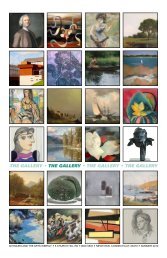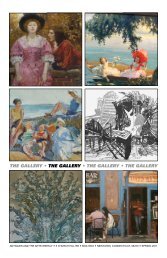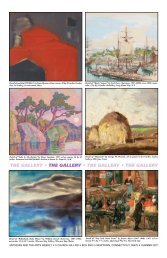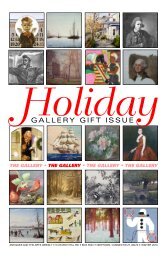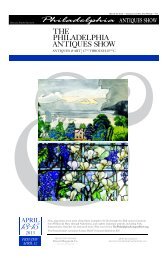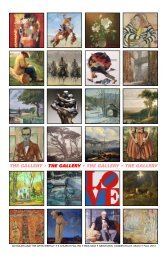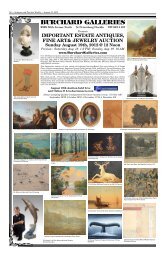the gallery the gallery the gallery the gallery - Antiques and the Arts
the gallery the gallery the gallery the gallery - Antiques and the Arts
the gallery the gallery the gallery the gallery - Antiques and the Arts
Create successful ePaper yourself
Turn your PDF publications into a flip-book with our unique Google optimized e-Paper software.
8 - THE GALLERY April 27, 2012 — <strong>Antiques</strong> <strong>and</strong> The <strong>Arts</strong> Weekly<br />
Elihu Vedder (1836–1923), “A Little Knowledge is a Dangerous Thing,” before 1880, oil on panel, 5 3 /8 by 13 3 /8 inches; signed on<br />
verso: “Vedder.”<br />
‘Myth And Reality: Elihu Vedder<br />
And American Painters In Italy’<br />
NEW YORK CITY — An exciting new<br />
exhibition will open Thursday, May 10, at<br />
Questroyal Fine Art, 903 Park Avenue,<br />
Suites 3A <strong>and</strong> 3B. “Myth <strong>and</strong> Reality:<br />
Elihu Vedder <strong>and</strong> American Painters in<br />
Italy” will feature more than 25 works by<br />
American artist Elihu Vedder<br />
(1836–1923). The majority of <strong>the</strong> pieces in<br />
<strong>the</strong> exhibition will be on loan from <strong>the</strong><br />
personal collection of Simon Parkes, a<br />
renowned painting restorer <strong>and</strong> conservator<br />
in New York City, who has passionately<br />
collected Vedder <strong>and</strong> related artists for<br />
many years.<br />
Best known as <strong>the</strong> illustrator of <strong>the</strong> 1884<br />
English translation of The Rubaiyat of<br />
Omar Khayyam, Vedder spent most of his<br />
life abroad <strong>and</strong> eventually made Italy his<br />
permanent home, dividing his time<br />
between Rome <strong>and</strong> <strong>the</strong> isl<strong>and</strong> of Capri. He<br />
Elihu Vedder (1836–1923), “St George <strong>and</strong> <strong>the</strong> Dragon,” 1866, oil on canvas, 7 9 /16<br />
by 9 5 /8 inches; dated <strong>and</strong> signed on verso: “Paris Feb. 1866 / Elihu Vedder.”<br />
brought a mystical sensibility to much of<br />
his art. Vedder’s paintings will be on view<br />
alongside works by his contemporaries —<br />
including Robert Scott Duncanson,<br />
Charles Caryl Coleman, William Stanley<br />
Haseltine, George Inness, Walter Launt<br />
Palmer <strong>and</strong> John Henry Twachtman — all<br />
of whom were similarly inspired during<br />
travel to <strong>the</strong> country.<br />
Vedder was greatly influenced by an Italian<br />
group of artists known as <strong>the</strong> Macchiaioli,<br />
whom he associated with while<br />
studying in Florence in <strong>the</strong> late 1850s.<br />
Vedder, with <strong>the</strong> Macchiaioli artists,<br />
rebelled against <strong>the</strong> academic Beaux <strong>Arts</strong><br />
style being taught at <strong>the</strong> time in favor of<br />
plein air painting.<br />
In <strong>the</strong> 1860s, <strong>the</strong> artist frequented Pfaff’s<br />
Coffee Shop in New York City where he<br />
met bohemian writers <strong>and</strong> poets, <strong>and</strong> his<br />
art began to be influenced by literature.<br />
The 1884 publication of The Rubaiyat was<br />
<strong>the</strong> culmination of Vedder’s fusion of fantastical<br />
stories with his artwork. His works<br />
can now be found in <strong>the</strong> permanent collections<br />
of <strong>the</strong> Brooklyn Museum; <strong>the</strong> Metropolitan<br />
Museum of Art; <strong>the</strong> Museum of<br />
Fine <strong>Arts</strong>, Boston; <strong>and</strong> <strong>the</strong> Smithsonian<br />
American Art Museum.<br />
Vedder’s narrative <strong>and</strong> imaginative compositions<br />
distinguish him from his many<br />
talented contemporaries. For example, “A<br />
Little Knowledge is a Dangerous Thing,”<br />
painted before 1880, depicts two mice,<br />
both of whom have died after nibbling <strong>the</strong><br />
lea<strong>the</strong>r-bound book behind <strong>the</strong>m; <strong>the</strong> title<br />
On View May 10–May 31 At Questroyal Fine Art<br />
William Stanley Haseltine (1835–1900), “Coast of Sori,” 1893, oil on canvas, 25 3 /16 by 45 5 /16 inches; signed <strong>and</strong> dated lower<br />
right: “W.S. Haseltine ’93.”<br />
Elihu Vedder (1836–1923) “Campagna<br />
Romana,” circa 1870, oil on canvas,<br />
11 7 /8 by 6 11 /16 inches (sight size); signed<br />
lower right: “Vedder.”<br />
reveals <strong>the</strong> cause of <strong>the</strong>ir tragic fate. Representative<br />
of his unique vision, values <strong>and</strong><br />
aes<strong>the</strong>tic pursuits, Vedder kept this study,<br />
an ironic moral tale of his own creation, in<br />
his studio for <strong>the</strong> remainder of his life.<br />
The artist’s imagination similarly dominates<br />
in o<strong>the</strong>r works such as “St George<br />
<strong>and</strong> <strong>the</strong> Dragon,” 1866. In this highly<br />
romanticized scene, Vedder portrayed St<br />
George as a literal knight in shining armor,<br />
swooping in on a Pegasus to slay a sli<strong>the</strong>ring<br />
dragon ready to devour <strong>the</strong> princess.<br />
Painted just one year after Vedder settled in<br />
Italy, “St George <strong>and</strong> <strong>the</strong> Dragon” reveals<br />
his fixation on <strong>the</strong> religious <strong>and</strong> superstitious<br />
aspects of Italian culture.<br />
Despite <strong>the</strong>se fantastical <strong>and</strong> mythical<br />
compositions — which foreshadow <strong>the</strong><br />
works he would create for The Rubaiyat —<br />
Vedder was also significantly inspired by<br />
<strong>the</strong> everyday beauty of <strong>the</strong> Italian l<strong>and</strong>scape.<br />
“Campagna Romana,” circa 1870,<br />
shows a vista down a winding path, leading<br />
into <strong>the</strong> Roman countryside, with o<strong>the</strong>r<br />
classic touches of Italian scenery such as<br />
<strong>the</strong> edge of a villa wall, cypress <strong>and</strong> umbrella<br />
trees <strong>and</strong> ruins at <strong>the</strong> foot of <strong>the</strong> mountains.<br />
As with <strong>the</strong> realm of <strong>the</strong> unreal, Vedder’s<br />
poetic mind <strong>and</strong> creative spirit were<br />
equally captured by such picturesque l<strong>and</strong>scapes,<br />
rich in ancient history <strong>and</strong> tradition.<br />
While Vedder can be considered a visionary<br />
artist, independent of established artistic<br />
schools, he was associated with o<strong>the</strong>r<br />
American artists who also ventured to Italy<br />
seeking inspiration in its l<strong>and</strong>scape. One<br />
such contemporary was William Stanley<br />
Haseltine (1835–1900), who, like Vedder,<br />
was drawn to settle in Rome. Haseltine’s<br />
“Coast of Sori,” 1893, reflects his own dramatic<br />
reaction to Italy’s splendor. In this<br />
dynamic composition, <strong>the</strong> rough sea crashes<br />
against <strong>the</strong> cliffs where a scraggly tree<br />
grips <strong>the</strong> ground tightly as it leans over <strong>the</strong><br />
steep edge. Diffused sunlight seeping<br />
through <strong>the</strong> branches offers romantic<br />
warmth, while <strong>the</strong> medieval tower in <strong>the</strong><br />
background, as in many of Vedder’s works,<br />
alludes to <strong>the</strong> prevalent force of history<br />
within this foreign l<strong>and</strong>scape.<br />
Questroyal is pleased to include in this<br />
project Dr Graham C. Boettcher, <strong>the</strong><br />
William Cary Hulsey Curator of American<br />
Art at <strong>the</strong> Birmingham Museum of Art. Dr<br />
Boettcher will lend his expertise on <strong>the</strong><br />
subject of an essay in <strong>the</strong> <strong>gallery</strong>’s accompanying<br />
exhibition catalog, which will be<br />
available by request <strong>and</strong> is complimentary.<br />
Gallery hours are Monday through Friday,<br />
10 am to 6 pm; Saturday, 10 am to 5 pm;<br />
<strong>and</strong> by appointment. For information or to<br />
request an exhibition catalog, call 212-744-<br />
3586 or visit www.questroyalfineart.com.



